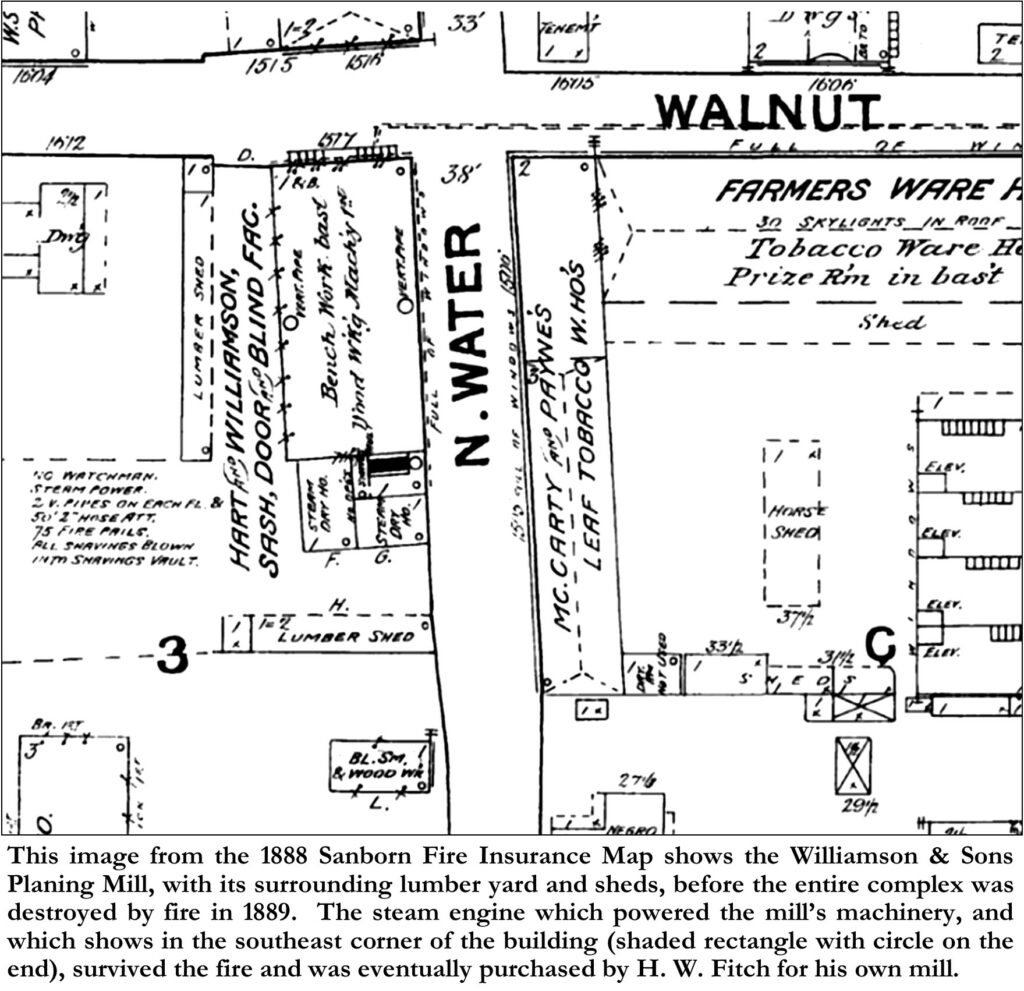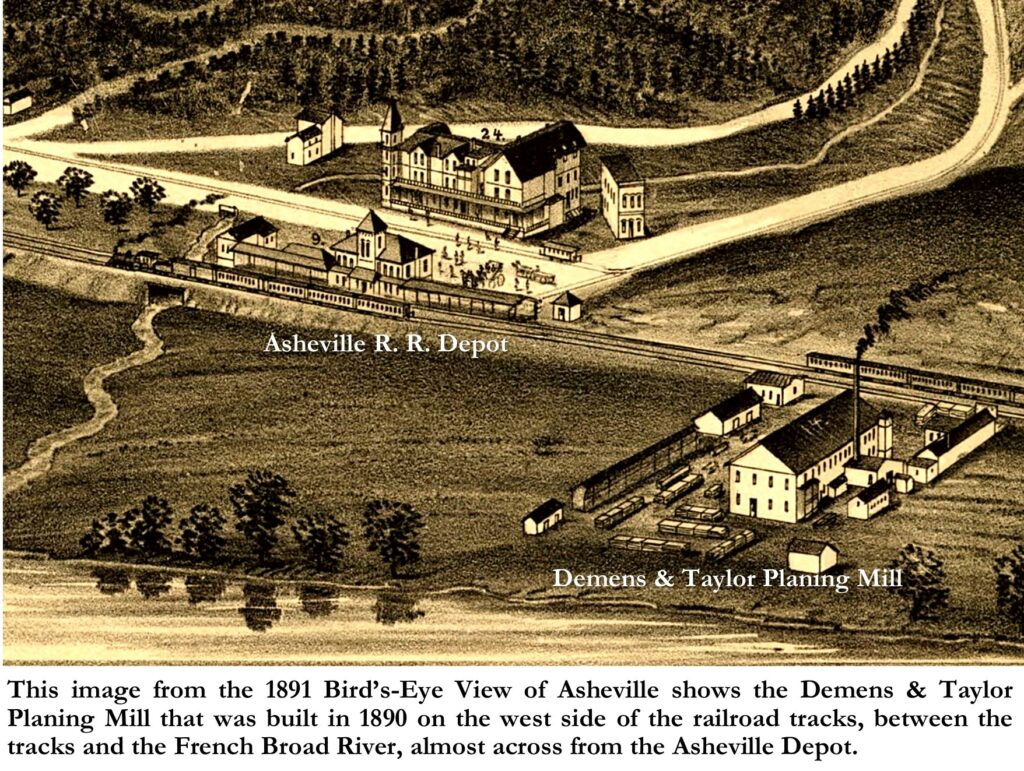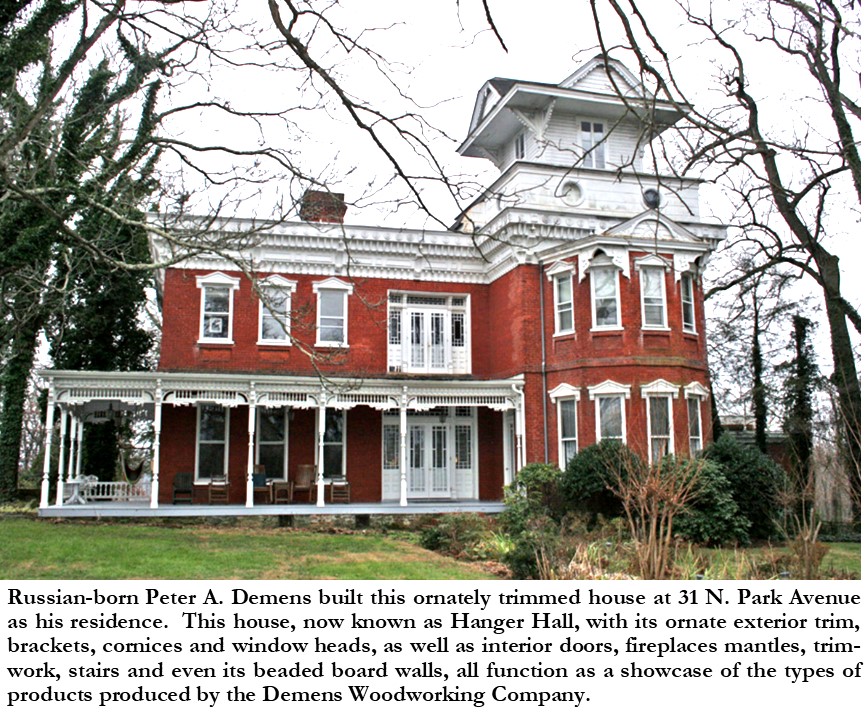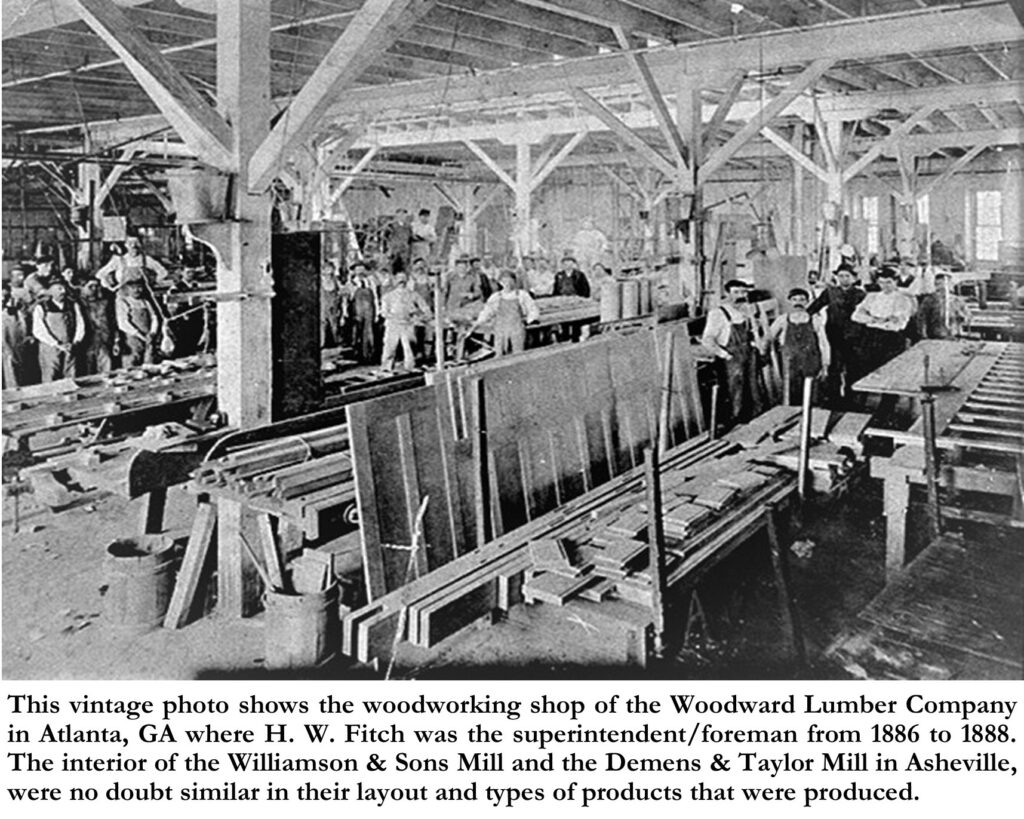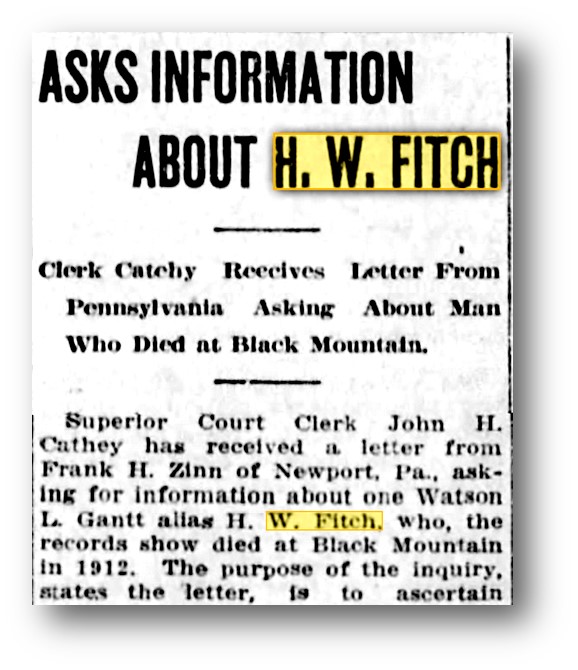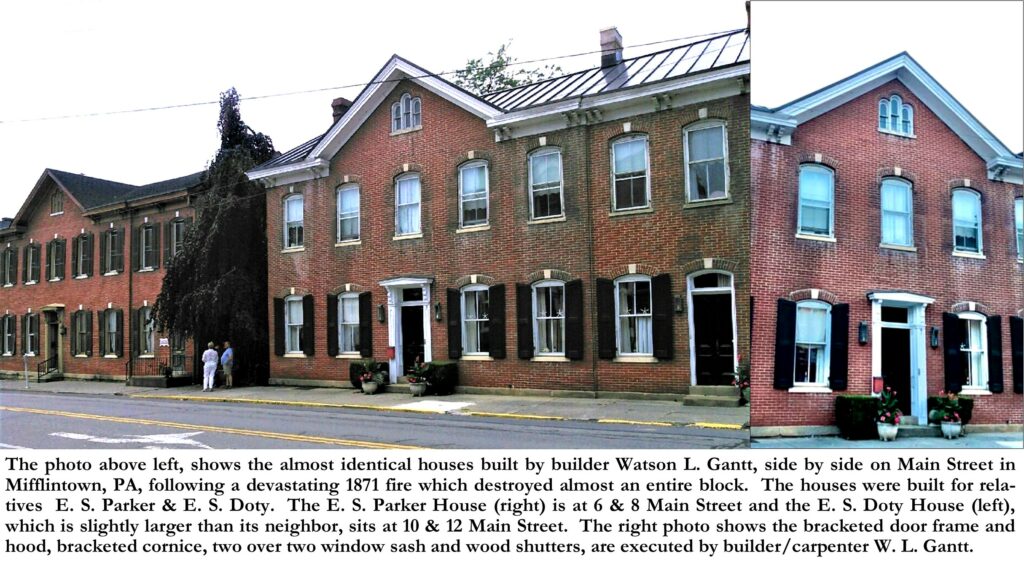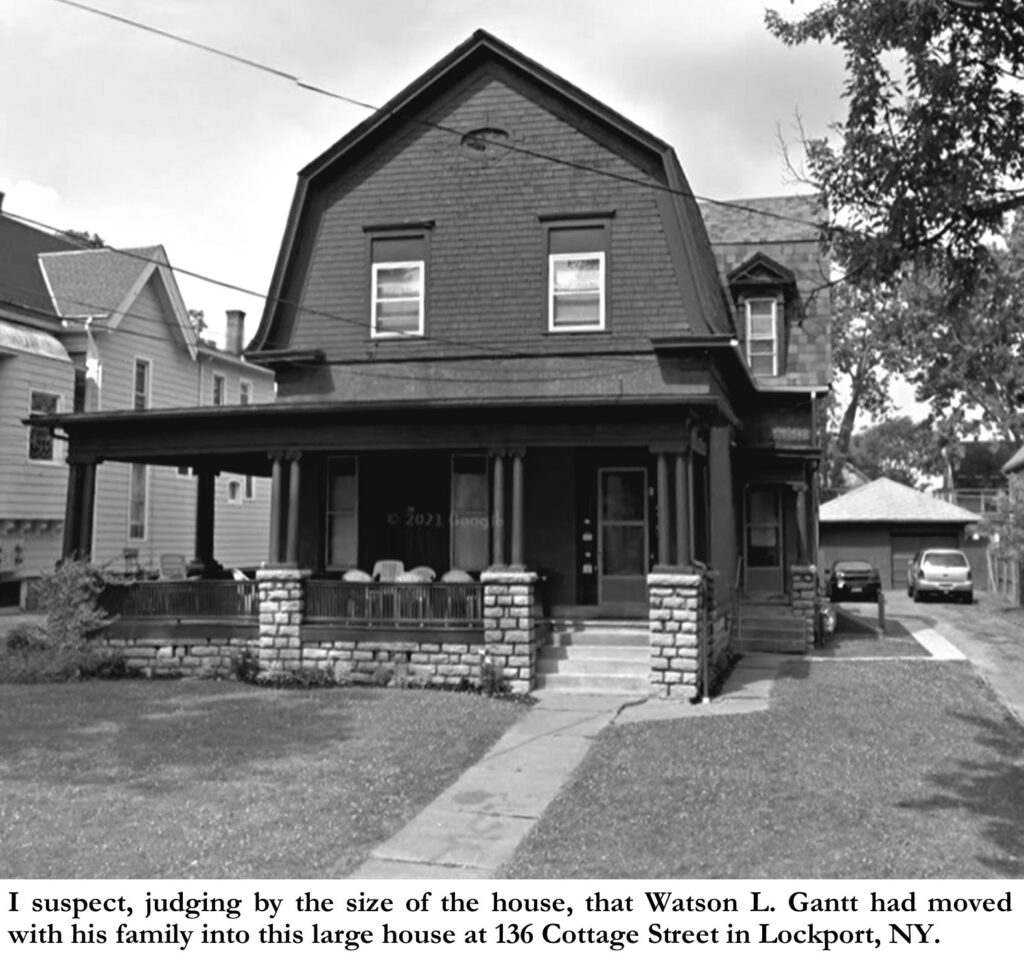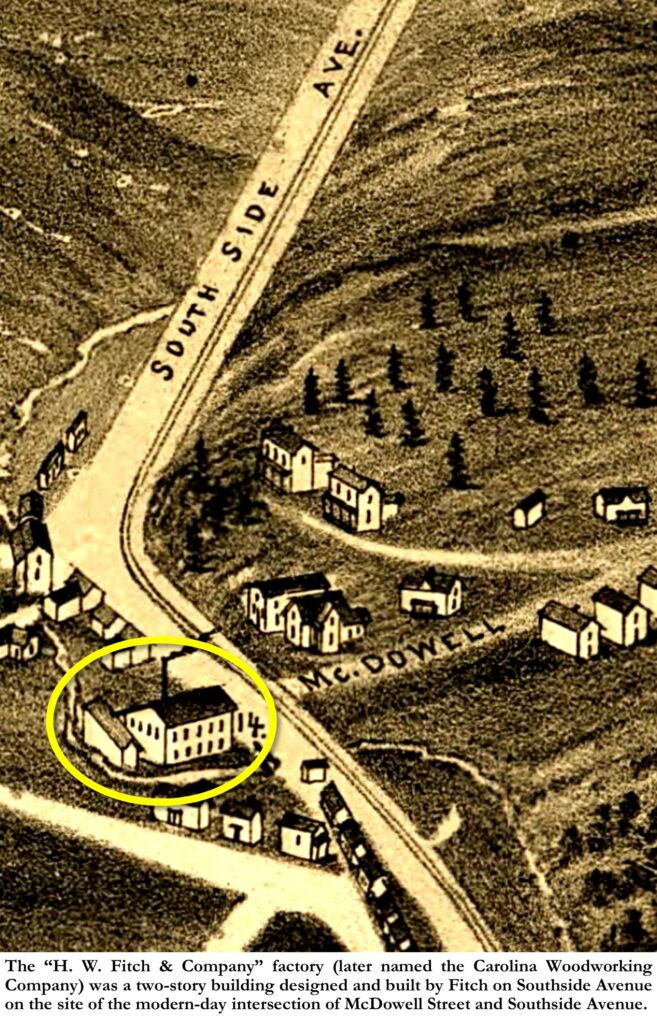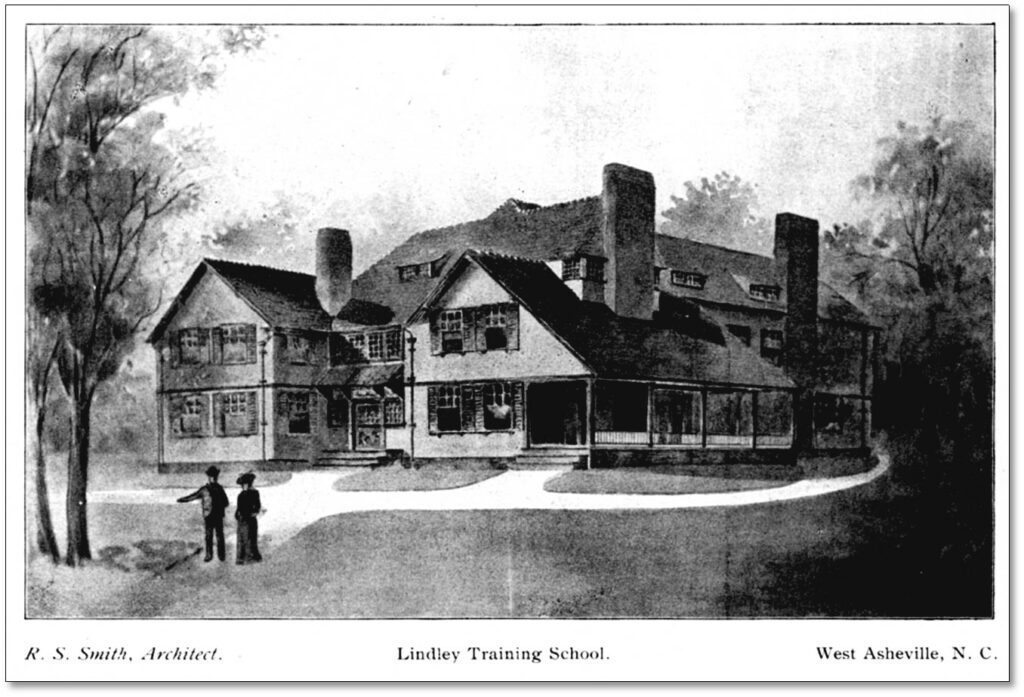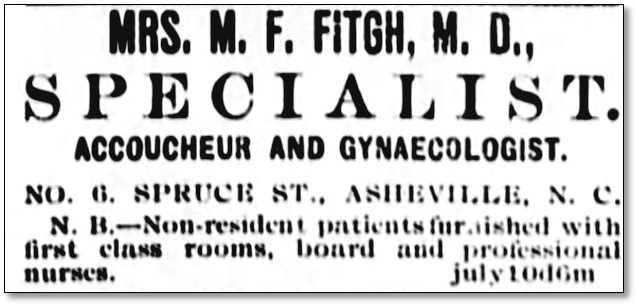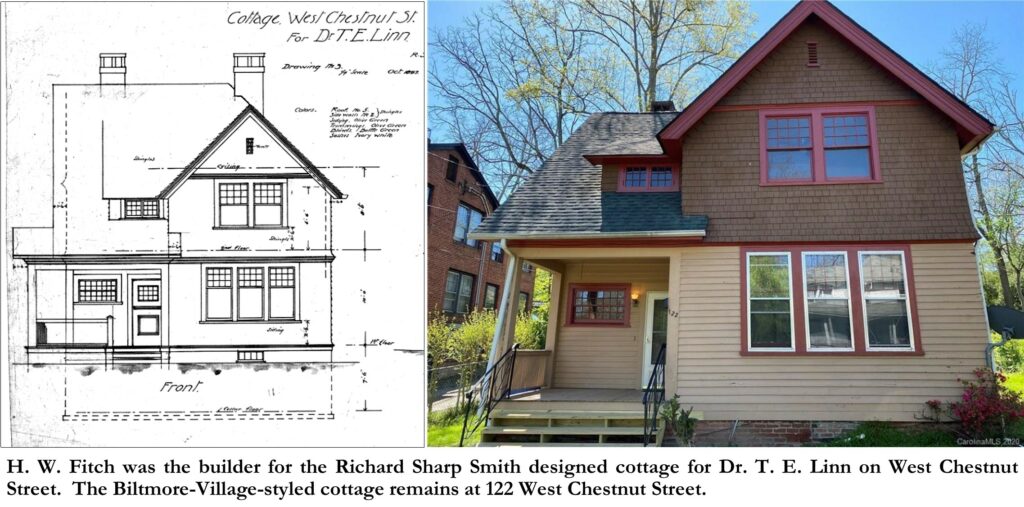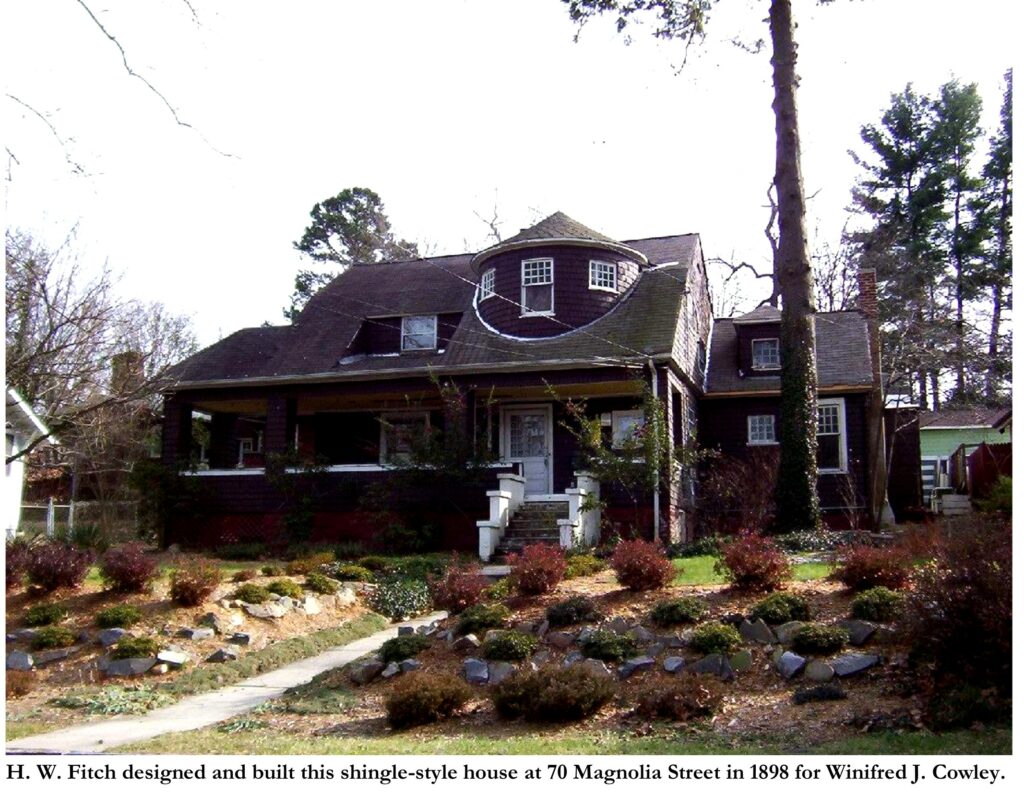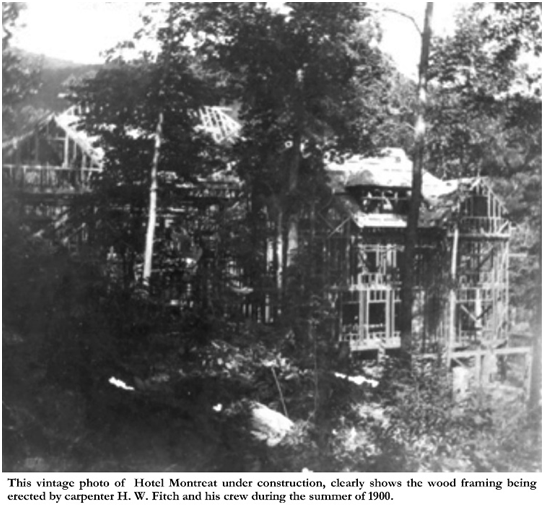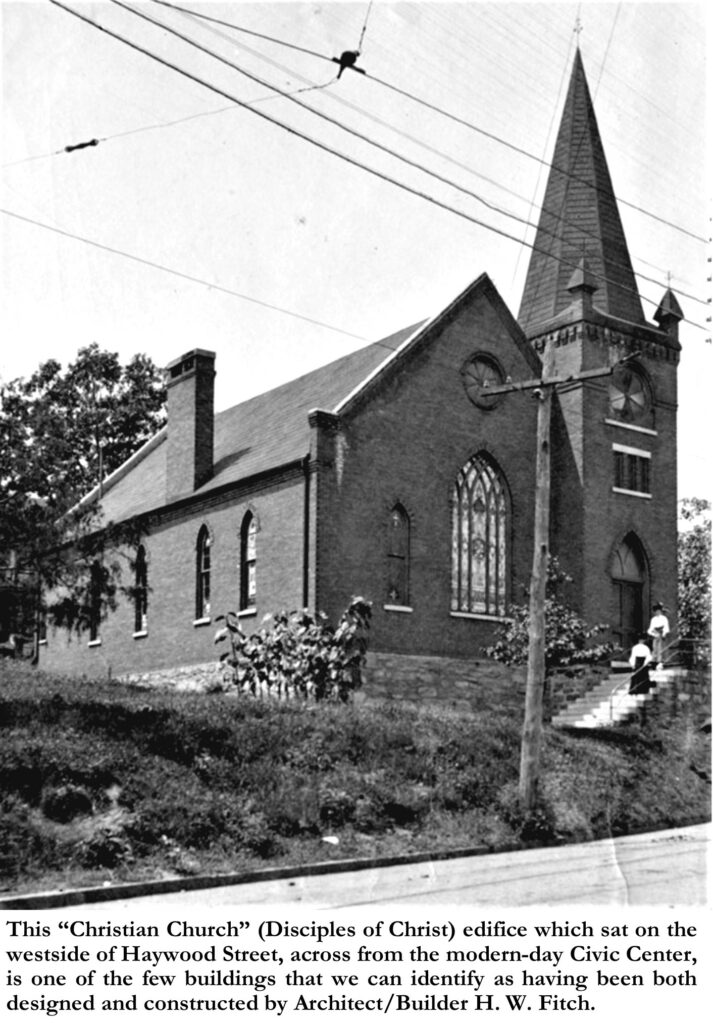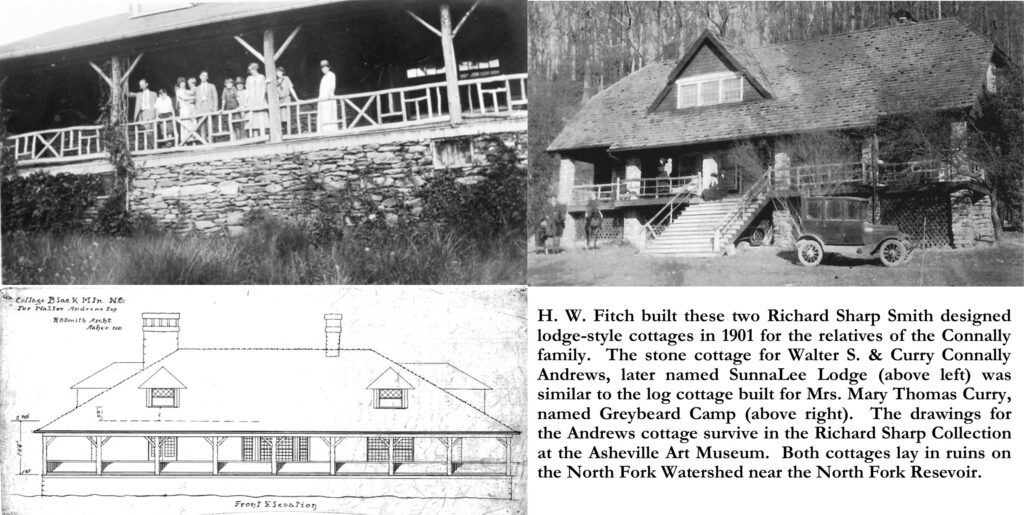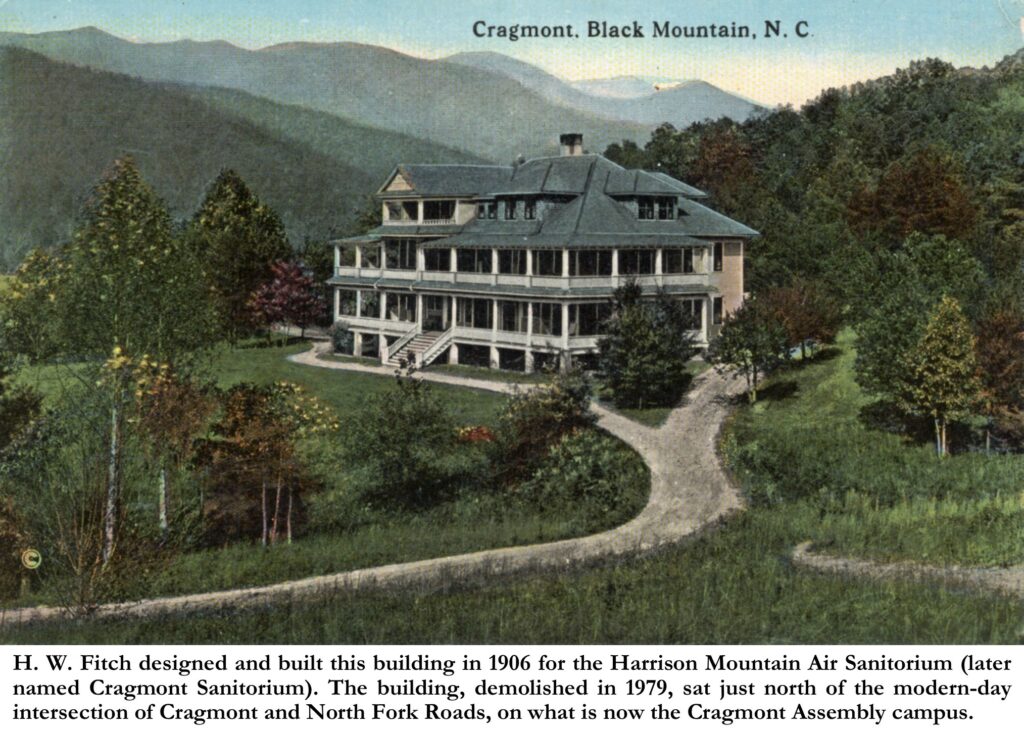By Dale Wayne Slusser
Architect and builder “H. W. Fitch”, at the age of 50, arrived in Asheville in 1888 from Atlanta, Georgia, and almost immediately began to make a name for himself in the building trades in Asheville’s then booming real estate and building development. His impact on Asheville’s built environment has been little known, and his story seldom told. So, who was “H. W. Fitch”? That is a question that his contemporary Asheville associates and friends, had no idea of asking, until after his death in 1912. In fact, both he and his “wife”, Dr. Mary T. Fitch who joined him in Asheville in 1889, had mysterious back stories, and were not who they appeared to be. Unraveling their stories proved to be a difficult task, and although few buildings designed or built by “H. W. Fitch” survive, his impact on the building of Asheville’s historic neighborhood’s, warranted the effort. Not to mention, that it makes a great story!
The first mention of “H. W. Fitch” in Asheville was on July 24, 1889, in a long newspaper article reporting on the recent destructive fire in which the Williamson & Sons Planing Mill was “burned to the ground”. “Mr. Fitch, the superintendent,” it was reported, “said just after the fire last night that he had no idea how the fire was caused.”[1] Apparently, Fitch had moved to Asheville to take the position as superintendent of the Williamson & Sons mill, which mill was built in 1885 on the west side of N. Water Street (now N. Lexington) at the southwest corner of the intersection with Walnut Street. Williamson’s planing mill produced furniture, millwork, doors and “blinds and sash” (shutters and windows), all of which were sold through their retail store on Patton Avenue.
H. W. Fitch was adroit at “landing on his feet”, and within a month of the Williamson & Sons fire, it was announced that H. W. Fitch was to be the superintendent of a new mill being built by Demens & Taylor, on the west side of the railroad tracks across from the Asheville Depot.[2] The new mill, which was reported to be “the largest and most completely equipped planing mill and woodworking establishment west of the Blue Ridge”[3], was being built by Florida developers, Peter Demens and his business partner, A. M. Taylor. A. M. Taylor had partnered on a former business venture for the Orange Belt Railway in Florida,[4] however he must have not had an active role in the Asheville project, as all the property records and deeds were in Demens name, and by 1890 Demens had incorporated the business as “P. A. Demens Woodworking Company”.[5] Peter A Demens, like “H. W. Fitch” was an alias (though for less nefarious purposes) for Russian-born, Piotr Alexewitch Dementief, who was born on May 1, 1850, in St. Petersburg, Russia, reportedly to an aristocratic family that owned estates in the province of Tver. “He was well connected socially and well educated; according to his Los Angeles Times obituary, he achieved the rank of Captain of the Imperial Guard and the title “Marshall of Nobility.” A man of democratic political opinions, he immigrated to the United States in 1881 with his wife, Raisse, and their four children; three more were born in this country.”[6]
Demens first settled in Longwood, Florida, and entered the lumber business; within a few years he was profitably building station houses for a branch of the South Florida Railroad. There is no evidence that Demens received any direct training in architecture or construction in his early years, and his role as a builder in this country was as a manager of money, men, and materials. Between 1886 and 1889 he devoted his energy to construction of the Orange Belt Railway from Sanford, Florida, to the Pinellas Peninsula, the site of present-day St. Petersburg, where he envisioned “a city of international importance” at the best natural harbor on Florida’s Gulf Coast. However, due to unreliable backers, delayed advance of credit; impatient creditors, and even an angry group of laborers demanding overdue wages who once threatened to lynch Demens, and despite completing the line, by mid-1889 Demens was forced to sell his interests to settle debts. However, he was successful in creating the rail connection that made St. Petersburg possible, and either Demens or one of his associates named the new town after his Russian birthplace.[7]
Today we can see an expression of Peter Demens and an example of the types of fine woodworking products manufactured by Demens Woodworking under the superintendency of H. W. Fitch, in a house built by Demens at 31 Park Avenue (now known as Hanger Hall). It’s Russian-style is exhibited in its ornately trimmed exterior and especially on its dominant tower, which at first glance resembles that of a Russian-Orthodox church. However, the house with its ornate exterior trim, brackets, cornices and window heads, as well as its interior doors, fireplaces mantles, trim work, stairs and even its beaded board walls, all function as a showcase of the types of products produced by the Demens Woodworking Company.
The first mention of Dr. Mary T. Fitch (that I have found) in Asheville, is from an August 1889 article which reported that “Mrs. M. T. Fitch, M. D., and daughter of Atlanta, arrived in the city last evening, and are stopping at the Oak Street Inn”.[8] “Mrs. F.” it was further reported, “is the wife of H. W. Fitch, Esq., the clever manager of Demens & Taylor’s mills in this city.”[9] Dr. Mary T. Fitch’s story is so intertwined with that of her “husband” H. W. Fitch’s story, that it too warrants our investigation. This short newspaper report offered three important leads, first that Mary T. Fitch was a doctor, secondly that she had come (at least recently) from Atlanta, and thirdly, that she had a daughter.
Upon further investigation, I found that Mary T. Fitch had arrived in Atlanta in the late 1880’s and on April 10, 1887, “Mrs. M. T. Fitch, M. D.”, began advertising as a “Specialist” in Gynecology and Obstetrics, with her office address being “50 Capitol Avenue, Atlanta, Georgia”.[10] She advertised that she was a “Graduate of Northern Allopathic and Southern Eclectic Colleges”.[11] Although her descriptions of “Northern” and “Southern” colleges was vague as to which specific institutions she was referring to, an article also from the April 10, 1887 Atlanta Constitution on page 11 (her advertisement was on page 12), was more specific. According to the article, she attended the University of Michigan for two years, the Women’s College of Chicago for one year, and the “Atlanta Eclectic” for one year.[12] The “Atlantic Eclectic” was first chartered in 1839 as the Southern Botanical Medical College, and in 1884 after several moves and name changes became the “Georgia College of Eclectic Medicine and Surgery.”[13] The college was part of the Eclectic Medicine movement which trained doctors to use noninvasive therapies and healing practices, such as herbal medicines, that were in “harmony with the body’s natural curative properties”[14], in opposition to the eighteenth-century medical practices such as applying leeches and bloodletting.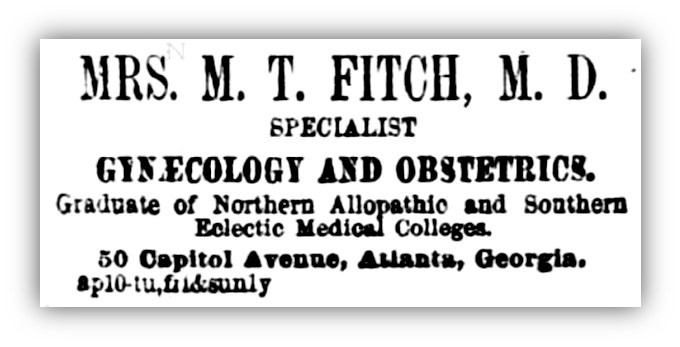
By January of 1887, H. W. Fitch was also living in Atlanta, as that month George S. May, the owner of May Mantle Company published in the Atlanta Constitution that he had “placed H. W. Fitch (formerly foreman for Woodward & Co.)” in charge of his factory.[15] According to both the 1886 and 1887 Atlanta City Directory, Fitch had indeed been the superintendent at D. Woodward & Company (aka Woodward Lumber Company).[16] Interestingly, in the 1886 directory, Fitch’s name is listed as “H. Watson Fitch” (an interesting clue as to his real identity), and he is listed as boarding at “Adams House”. By 1887, Fitch had moved to a boarding house at 50 Capitol Avenue[17], where in 1888, he was joined by “Mrs. Mary T. Fitch, physician”,[18] and no doubt also by her daughter Bessie. But where was “H. W. Fitch” prior to coming to Atlanta in 1886? Perhaps this is the time to reveal just who was “H. W. Fitch”, aka “Henry W. Fitch” and aka “H. Watson Fitch”? Like their contemporaries, we would have no reason to question his identity if it were not for the intriguing article posted in the Asheville Citizen Times in January 1916, a few years after the passing of both Henry and Mary Fitch. “ASKS INFORMATION ABOUT H. W. FITCH”[19], was the eye-catching title of the article. In the article it was reported that, “Superior Court Clerk John H. Cathey has received a letter from Frank H. Zinn of Newport, Pa. asking for information about one Watson L. Gantt alias H. W. Fitch, who the records show, died in Black Mountain in 1912. The purpose of the inquiry, states the letter, is to ascertain whether the deceased obtained an divorce from Margaret Gannt, for whom Mr. Zinn is trying to get a widow’s pension from the government.”[20] The article went on to quote from the letter the following account: “Gannt deserted his wife in 1875 and in 1894 came to Black Mountain under the name of H. W. Fitch with another woman purported to be his wife. They lived there until the woman died in 1910, and Fitch surviving her by but a short time, died in 1912.”[21] Of course, we know that “Mrs. & Mrs. Fitch”, came first to Asheville in 1888-1889, before settling in Black Mountain. The article also reported that the Superior Court Clerk replied to Mr. Zinn’s inquiry that “no divorce was granted Mr. Fitch or Mr. Gantt in Buncombe County”![22] For an inquisitive historian, like me, the short article, although revealing Fitch’s real name, also brought up a host of questions. Who was Watson L. Gannt, and was he really an experienced carpenter/builder? Where was Fitch living and what was he doing between 1875 and 1888? And what was the relationship between Fitch and his “wife”, Mary T. Fitch? For that matter, who was “Mary T. Fitch”, and how and where did they meet, and was she perhaps the cause of Fitch’s desertion of his wife and family in 1875? Using census data, historical documents, and contemporary newspaper accounts, as well as clues from Mary T. Fitch’s obituary, the answers to my questions slowly revealed their probable story.
Watson Lee Gantt was born on May 2, 1838 to Jacob & Eleanor (Bosserman) Gantt at Lockport in Niagara County, New York. By 1860, Watson Gantt had moved to Newport, Perry County, Pennsylvania (which was his father’s birthplace), where he was working as a Machinist, and was boarding with farmer William Kough and his family.[23] On October 16, 1860, Gantt married Kough’s daughter Margaret Kough. Although the 1860 census lists Gantt’s occupation as “Machinist”, which could have meant a machine operator in a planing mill, it is clear from other sources that early on Gantt was working as a carpenter/builder. In February of 1863 it was reported that he had been paid $277 by the Perry County for building a “bridge in Rye Twp.”[24], and that in 1864 Gantt was paid $119.50 by the county for building a “bridge across Fishing Creek”.[25] In the summer of 1863, Gantt served as a Sergeant with Co. B, 36th Pennsylvania Militia, (July 4 – August 11, 1863) during the Battle of Gettysburg, but then went back to work in Perry County until August 31, 1864, when he then enlisted in the Union army. On September 5th he was mustered as a private into the Company G, 208th Pennsylvania Infantry. Gantt served until he was discharged on his company June 1, 1865, returning home to his family and work in Perry County.[26] He appears to have returned to a job at the Newport Planing Mill, and as an agent for the “Cayuga Chief”, a combined reaper/mower.[27] By 1871, he was working as an independent contractor. In April of 1871, it was reported that he was busy building two brick houses on Main Street in downtown Mifflintown, PA- one for E. S. Doty and one E. S. Parker.[28] These were two of sixty buildings destroyed in a devastating New Years Day 1871 fire.[29]
In 1873, Watson L, Gant was employed as a foreman at the C. H. & J. W. Peck Co., a Door, Sash, and Blind factory in St. Louis, Missouri.[30] He returned home to his family, and in 1874 he moved his family from Newport, PA back to his hometown of Lockport, NY, where he got a job as the Manager of the Union Planing Mills. The family moved into a house at 136 Cottage[31], where their third child, Percival was born on August 24, 1874.[32] It was while living in Lockport, NY in 1875, I surmise, that Watson L. Gantt deserted his family. I also surmise that it was in Lockport, NY that Gantt met “Mary T. Fitch”, who was living in Lockport at 1 Pine Street, just two blocks from the Gantt family[33]. The 1875 New York State Census lists Mary T. Fitch as a “Dressmaker”[34] living in Lockport, as the head of a household that included her son Bertie S. Fitch (age 16), as well as her nephew William Stevens and her niece Katie Stevens. So, who was “Mary T. Fitch” and why was she living in Lockport and who was the father of her son?
“Mary T. Fitch”, was born Mary Thomas Nichols, in 1836, in the town of Whitby, Ontario, Canada to Rhode Islander Barber Nichols and his second wife Lucy Parshall Nichols. Mary T. Fitch was named for her father’s first wife Mary Thomas Nichols, who died in 1824. Mary Thomas Nichols bore thirteen (six boys and seven girls) to Barber Nichols, and at the time of the marriage of Barber Nichols to Lucy Parshall in 1830, there was eleven of Mary’s children living. Lucy Nichols, in addition to raising eleven stepchildren, bore seven children (five girls and two boys), making Barber the father of twenty children.[35] Around 1850, Barber Nichols moved his family to Lockport, NY, just across the border from Ontario, Canada. Sometime around 1859, Mary T. Nichols met a young Naval Engineer, Henry Winslow Fitch, of Fairhaven, Massachusetts. The 1860 US Census has Henry W. Fitch, Engineer, living with Mary T. Fitch and their 1-year-old son, Bertie S. Fitch in a house in Brooklyn, NY.[36] Henry W. Fitch had graduated from the Naval Academy, at Brooklyn in 1859, and had been warranted as a “third assistant engineer” and assigned to the “Narraganset”. The “Narraganset” was commissioned in 1859 in Boston and ran up and down the East Coast until the Spring of 1860, when it then headed to the Pacific with the primary mission of protecting American mail steamers from Confederate raiders.[37]
By the 1870 Census, Engineer Henry W. Fitch, though still in the U.S. Navy, was living alone in Brooklyn[38], and I suspect that Henry and Mary had already separated by then. In fact, the 1865 New York State Census, shows that Mary T. Fitch had returned to Lockport, with her son Bertram, and she was working as a dressmaker.[39] Mary T. Fitch is shown in the 1875 New York State Census, still living in Lockport.[40] But in an 1874 Lockport city directory, Mary T. Fitch is shown as living at 1 Pine Street, and just a block away, “Watson L. Gantt” is living at 136 Cottage Street.[41] Gantt’s parents, as well as his brother Ephraim W. Gantt and his family were also living in Lockport at the time. Watson L. Gantt was employed as the manager of the Union Planing Mill, located on Elm Street near East Avenue.[42] It’s unclear if Gantt was living in Lockport with his family or not, however, I suspect that he was, and that Lockport is where and when he deserted his family, and fled with Mary Fitch to Ontario, Canada.
Neither Mary T. Fitch, nor Watson L. Gantt show on any 1880 census, but other references indicate that they were living in Ontario, Canada during the early-mid 1880’s. When “Mary Thomas Fitch” enrolled at the University of Michigan from 1883-1885, she gave her residence as “Ontario”,[43] and consequently when Jacob Gantt died at Lockport in 1884, his obituary listed among his surviving children, “Mr. W. L. Gantt of Ontario”.[44] Another reference we have is that in 1883, Gantt applied for a Civil War Pension as an “invalid”, filing his application from Ontario.[45] Why the couple decided to move to Atlanta in 1886 is unknown, but I suspect they may have thought it would be better for their daughter, Bessie Fitch, who was born in 1877. I also suspect that Watson L. Gantt took the alias of “H. W. Fitch”, also for the sake of their daughter. Having a different last name from his daughter and his “wife” would be uncomfortable for his daughter. Of course, it would also bring attention to himself and his relationship to his “wife” and daughter, which would not be safe for a man on the run!! It was a creative solution to use Mary’s first husband’s name, but with a twist, switching “Winslow” for Watson, this no doubt allowed Mary to continue to call Gantt by his familiar first name.
Sadly, only a few months after moving to Asheville in 1889, while the Fitches were still staying at the Western Hotel, young Bessie C. Fitch suddenly died “after a brief illness” on October 4th.[46] Perhaps Bessie had a condition which prompted the Fitch family to seek the healthful climate of Asheville. The funeral was held “from the Western Hotel”, the following day, and her small body was interred at the newly opened Riverside Cemetery. Her parents had a gravestone erected and inscribed: “Bessie C. Fitch, Daughter of H. W. & M. T. Fitch, Died October 4, 1889, Age 12 yrs 6 mo 11days”.[47]
Although “H. W. Fitch” was an alias name, “H. W. Fitch” was not an alias builder, and in fact by the time he reached Asheville he was an experienced and competent carpenter/builder/woodworker. So, it was not surprising that after working for Williamson & Sons, and Demens & Taylor, in 1890, Fitch decided to go it alone and establish his own business, “H. W. Fitch & Co.”. It was first announced in January of 1890 that Fitch was building his new woodworking factory “on North Water Street near Main”[48], however, just three weeks later it was correctly reported that the new factory was being built on Southside Avenue.[49] “H. W. Fitch & Co.”, which consisted of Fitch and his business partner, Berry G. Saunders, built a two-story brick building, on the northside of Southside Avenue. The location of the new factory was near the modern-day intersection of Southside Avenue and McDowell Street. The new factory was set up as a planing mill and woodworking shop, on the same lines as Demens & Taylors’ factory, and interestingly was built just up the hill from the Demens establishment.
The H. W. Fitch & Company’s new factory was first put into operation in March of 1890, and in April they advertised that they were “ready to do all kinds of work in the housebuilding lines”.[50] The fully equipped factory, which employed 15-20 workmen, contained a “full line of the very best machinery for the manufacture of mantles, interior finish, stair and veranda work, mouldings, frames, and general fine and plain wood-working jobbing”.[51] A few months after the factory began operation, in August of 1890, Fitch and Saunders decided to take on additional partners by incorporating. The new corporation, starting with $12,000 worth of capital, was named “Carolina Woodworking Company” and included the following officers: W. B. Williamson, President; B. G. Saunders, Vice-President; J. E. Dickerson, Secretary and Treasurer, as well as the following Directors: G. A. Shuford, C. E. Moody, C. B. Leonard, and R. L. Fitzpatrick, with H. W. Fitch as Manager.[52]
“H. W. Fitch” seemed to have an entrepreneurial spirit, yet he did not seem to hang around very long after he would start a business, and so not surprisingly, by the Spring of 1891, he was on to new ventures. This was probably a good move, as after only a few years of business, the Carolina Woodworking Company began having financial problems and then after becoming embroiled in a bank scandal, ending up in receivership by 1897. In May of 1890, H. W. Fitch began to advertise his services as an “Architect and Superintendent”, rightfully claiming that he had “31 years practical experience”.[53] He opened an office on one of the upper floors of the Battery Park Bank, which sat at 13 Patton Avenue, (the site is now the southside of the Hotel Arras).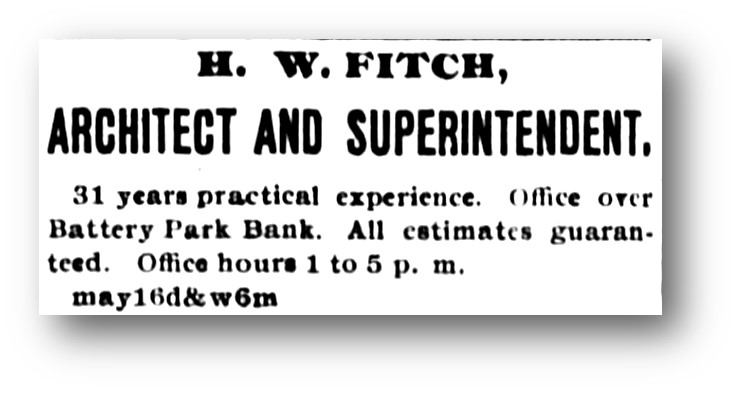
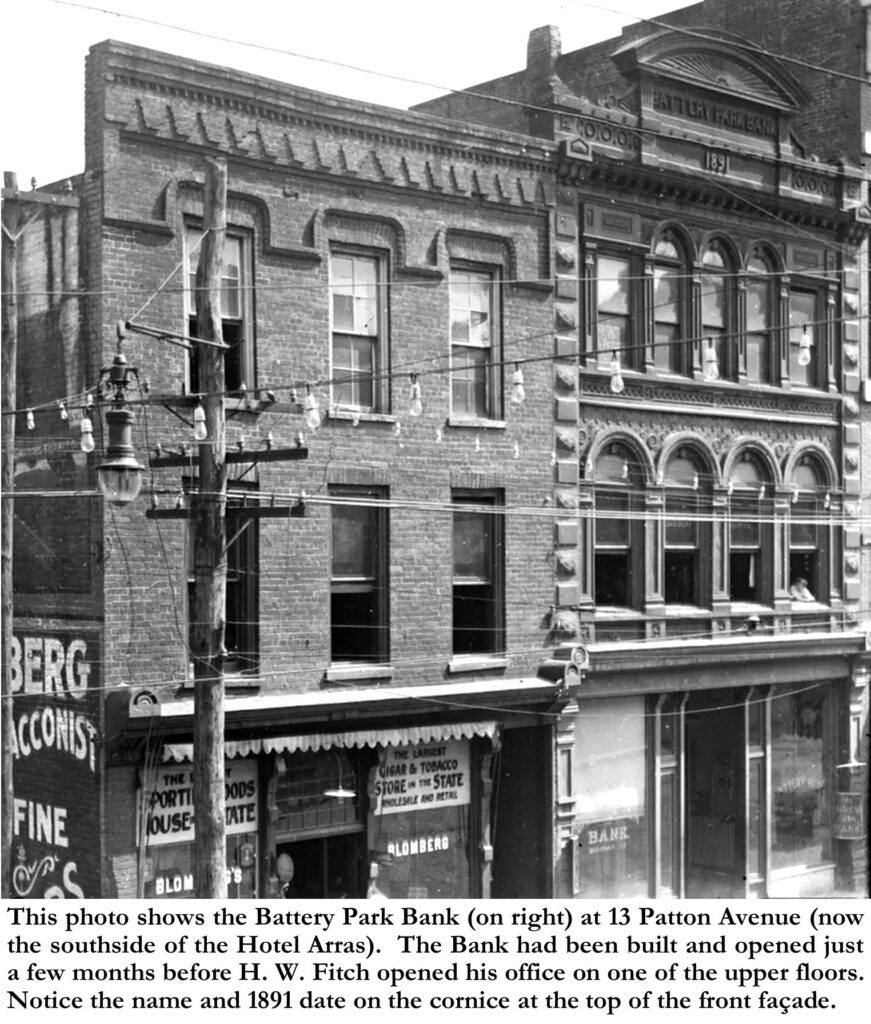
By 1891, H. W. Fitch’s competency was acknowledged by his colleagues as his name was one of five men nominated for the position of City Building inspector. Although he lost out to builder E. W. Burkholder on a second vote[54], his nomination was evidence of his respected reputation.
The first project of H. W. Fitch as architect and builder was a five-room frame cottage for F. N. Carrington on Park Avenue.[55] Unfortunately in 1893, just two years after being built, the two-story house, built at 17 Park Avenue, was destroyed by fire. The current one-story house at 17 Park Avenue, is either rebuilt from the remains, or is a replacement house built on the same site.
In 1892, Fitch received the contract to erect a new Presbyterian Church at Statesville, NC. However, it was reported that because he “failed to come to taw” (follow-through or show up) the contract was eventually rewarded to another builder.[56] Perhaps Fitch decided the travel to Statesville was not worth it, but he did have other projects going as well. One was a major contract for the “wood work” for the Richard Sharp Smith designed “West Asheville Training School For Women”.[57] The reformatory school, to be named “Lindley Training School”, was the brainchild of Mrs. Clarence Mitchell of New York who was living in Asheville. The school was financed by Mrs. Mitchell and “an association of benevolent women”[58] including Mrs. W. H. Vanderbilt of New York and Mrs. George Vanderbilt. The school was named by Mrs. Mitchell for her parents, Rev. & Mrs. Daniel Lindley, former missionaries of South Africa.[59] The “wood work” in which Fitch was responsible was most likely all the carpentry, including framing, exterior and interior trim, doors, windows, mantles, and stairs.
While H. W. Fitch was heavily involved in business, Dr. Mary T. Fitch, an independent woman, in addition to taking in boarders in their house at 6 Spruce Street (behind the City Hall), she decided to hang up her shingle and began to advertise her services as an “Accoucheur and Gynaecologist”. An “Accoucheur” is a person who assists during childbirth, especially an obstetrician.[60] In 1891, Mary Fitch purchased 80 acres near Lakey Gap, southeast of Black Mountain.[61] Besides planting an orchard of three hundred trees[62], Mary Fitch built a log cabin on her Black Mountain property. Mary named her cabin, “Jug Rock Bungalow”, for its location near the “historic rocks at Lakey Gap”.[63] Mary described her bungalow as a “little rude cabin” made of “split logs and split shingles”, with a “chimney built of mud and stones stopped at half mast”.[64] In January 1893, Mary T. Fitch filed a “free trader” agreement with the Buncombe Superior Court. A Free Trade agreement allows a spouse to sell property in his or her individual name without the other spouse having to sign the deed. Although this is typically made after a divorce, I suspect that Mary Fitch wanted to get into the real estate business and wanted to be able to buy and sell property without complicating the transactions with her spouse (who she secretly knew was not legally her spouse), and therefore not allowing Fitch’s (Gantt’s) first wife to have any claims of inheritance on Mary’s properties.
H.W. Fitch had numerous projects during the years 1893-1900, unfortunately few of those were reported and of those reported, I have only been able to verify a handful. In 1893, Fitch prepared drawings for the Tennessee Furniture and Lumber Company being established in Elizabethton, TN by J. Y. Jordan of Asheville. Jordan had purchased the Asheville Furniture and Lumber Company and decided to relocate its operations to Elizabethton. The year before Jordan and R. L. Graham had moved their Shoe Factory from Asheville to Elizabethton. Fitch designed a two-story, “80 x 150 feet” brick building for the new factory.[65]
In 1896, Fitch began advertising both locally and in Charlotte and Atlanta,[66] his design services in the form of a “plan service”, called, “Carolina Building Plan Association”, where clients could select plans from his “portfolio of carefully drawn plans”. I have only found two advertisements, one in 1896 and one in 1898, but little other information about the plan service, except that the portfolio included “all classes of modern buildings, at very low prices”,[67] including plans for residences, stores, churches, schools and courthouses.
I can find no report of any projects undertaken by H. W. Fitch during the years 1894-1896. But then in November of 1897, it was reported that “Dr. T. E. Linn has let to Contractor Fitch the contract to erect a six-room cottage on West Chestnut street”.[68] The report went on to say that the plans for the house were prepared by architect R. S. Smith. The house, which remains at 122 W. Chestnut Street, resembles both in plan and style one of the cottage designs which R. S. Smith was designing for George Vanderbilt in Biltmore Village at the time.
On the heels of the Linn house, in January 1898, it was reported that a permit was “given to H. W. Fitch to erect a seven-room house on the south side of Magnolia avenue between Flint Street and Cumberland Avenue.”[69] The house for which a permit was given to Fitch to build on the southside of Magnolia, was for Winifred J. Cowley, the wife of Alexander Cowley. The Cowley’s had just completed another investment property on the adjacent lot to the west (there were then only two lots on Magnolia between Flint & Cumberland), which still sets at 153 Cumberland Avenue. The Cowley’s kept the Fitch-built house as a rental property until selling it in 1904 to George T. Barnard, who unfortunately died in the house within the year. The house that Fitch built, and I believe also designed, for Mrs. Cowley was a two-story Queen Anne Shingle-style house which still sits at 70 Magnolia Avenue.
By 1900, H. W. and Mary Fitch had moved permanently to Black Mountain, first living at their farm at Lakey Gap and by 1910 in town on Briggs Street (now Broadway).[70] In 1900, H. W. Fitch was awarded the contract for the carpentry, for the new hotel being erected at Montreat.[71] The new hotel, was designed by Richard Sharp Smith, and financed by candymaker mogul, John S. Huyler. It can be assumed that the carpentry in which Fitch was responsible for included all the wood framing, doors, windows, stairs, as well as the exterior and interior trim work. A vintage photo taken while the hotel was being built, clearly shows the extensive wood framing erected by H. W. Fitch and his crew.
In the Fall of 1900, H. W. Fitch received the commission in Asheville for both the design and construction of a new brick church for the “Christian Church” (Disciples of Christ) on Haywood Street. The “60 x 40 feet”, “red brick building”, with stone trimmings,” contained a sanctuary “with a seating capacity of 300”, as well as a baptistry, study and other ante rooms.[72] The new church was completed and opened for services in February 1901. Among the features of the new church were four stained-glass windows, one of which was installed in memory of Fitch’s daughter, “Miss Bessie Fitch.”[73]
In February 1901, a newspaper article titled, “Unique Cabins” announced that “Architect R. S. Smith has just finished plans for two unique cabins to be built near Colonel Connally’s mountain home, near the foot of Black Mountain. One is for Mrs. Andrews, his daughter, the other for Mrs. Curry, Mrs. Connally’s sister.”[74] More specifically, “Mrs. Andrews” was Curry Connally Andrews who was married to Walter S. Andrews, and “Mrs. Curry” was Mary Thomas Curry, the sister of Alice Thomas Connally, who was married to Dr. J. L. M. Curry. The two cabins were identical in plan but looked different from each other as the Curry Cabin was built of large log walls, and the Andrews Cabin was built of stone walls. However, both cabins “are on the order of bungalows” and both had verandas on all sides, supported by large vertical log or stone posts. The two-story living rooms in the center of each of the cabins had an immense stone fireplace, and off the large living room were a dining room and first floor bedrooms, with additional bedrooms and baths on the balconied second floor opened to the living room below. The article further announced that “H. W. Fitch of Black Mountain” had been given the contract to build both cabins.
Colonel J. K. Connally and his wife Alice Thomas Connally of Fernnihurst, had in the late 1880’s purchased a large tract of land on the North Fork at the foot of Black Mountain, which included the old Jesse Stepp Tavern/Inn in which Elisha Mitchell had stayed on his tragic trip to measure Mount Mitchell in 1857. The Connallys installed the Colonel’s friend Arch Tyson as the proprietor of the Old Stepp Inn and built their own stone “cabin” southeast of the old Inn. The new Curry cabin (named Greybeard Camp) was built northwest of the Connally cabin just below the Old Stepp Inn, and the Andrews cabin (later named Sunnalee) was built below the Connally cabin. Unfortunately, both cabins are now in ruins and are part of the guarded North Fork Watershed. One can see their remains on the periodic tours of the North Fork sponsored by the Swannanoa Valley Museum.
H. W. Fitch became active in civic government when he moved to Black Mountain, being elected mayor in 1901[75], and being appointed in 1903 for a two-year term as justice of the peace.[76] Ironic for a bigamous on the run!
The last recorded project for architect/builder H. W. Fitch was in 1906 when he was commissioned to design and build a new sanitorium in Black Mountain, on North Fork Road for Dr. Wallace K. Harrison of Chicago, IL and his associate Dr. Isaac J. Archer of Black Mountain. Although founded as the “Harrison Mountain Air Sanitorium”[77], the sanitorium was operated by Dr. Archer and commonly known as “Cragmont Sanitorium”, a variant of “Gragmont” perhaps derived from the land having been purchased from John Gragg. In 1916, the name was officially changed to Cragmont Sanitorium. Architect Fitch designed the sanitorium as a large two-story frame structure surrounded on three sides by extensive two-story porches, needed for the patients to get their required “mountain air”, which was a vital part of their treatment. The building was built just north of the modern-day intersection of Cragmont and North Fork Roads, on what is now the Cragmont Assembly campus. The original Cragmont building was demolished in 1979 and replaced by a modern building on the same site.
In 1909, H. W. Fitch was listed in the Asheville City Directory as boarding at the Houston Hotel and working as a superintendent at the Asheville Mill & Building Company.[78] The Asheville Mill & Building Company had been established by Asheville incorporators C. T. Rawls, P. R. Moale, Louis Bourne, S. Mongomery Smith and others, as a lumber and building company providing “the complete material for houses prepared as far as possible for set up”.[79] This was on the lines of the early twentieth century “kit houses” being produced by Sears Roebuck and Wardway Companies. I suspect H. W. Fitch, although approaching 70 years of age, was still in need of generating an income. However, this was the only year that he worked for the Asheville Mill & Building Company.
On August 5, 1910, Dr. Mary T. Fitch passed away at her home in Black Mountain at the age of 80. According to her obituary, several years previous she had suffered “a stroke of paralysis”, necessitating her move to Black Mountain.[80] Dr. Mary T. Fitch was buried at Riverside Cemetery next to her daughter Bessie.[81] H. W. Fitch survived Mary by two years passing away quietly on April 1, 1912 at Black Mountain (I’ve found no obituary for him). He was buried at Tabernacle United Methodist Church Cemetery near Black Mountain.[82]
Despite his personal faults, architect and builder, “H. W. Fitch” (Watson Lee Gantt) contributed his fair share to the built environment of Asheville and Buncombe County. Its impossible to adequately assess his legacy to today’s historic buildings, as there may be hundreds of doors, windows and woodwork in Asheville’s historic houses which were produced by Fitch’s several woodworking factories, not to mention whole houses that were designed and/or built by him which have yet to be identified.
Photo Credits: All captions by Dale W. Slusser
Sanborn 1888 Map, Williamson &Sons- Asheville Map, November 1888, Sheet 2- Digital Sanborn Maps, 1867–1970, NC Live.org
1891 Asheville Bird’s Eye View, Demens & Tayor- Ruger & Stoner, and Burleigh Litho. bird’s-eye view of the city of Asheville, North Carolina. [Madison, Wis, 1891] Map. https://www.loc.gov/item/75694894/
Peter Demens House (Hanger Hall) Photo by Richard Hansley, Collection Number 44611, ID: RHC-073-DS, Buncombe County Special Collections, Pack Memorial Library, Asheville.
“Mrs. M. T. Fitch, M. D.” Image –The Atlanta Constitution, Atlanta, GA-April 10, 1887, page 12.-Newspapers.com
Woodward Lumber Company, Atlanta –Photograph of Woodward Lumber Company, Atlanta, Fulton County, Georgia, 1910-Georgia Archives- https://dlg.galileo.usg.edu/
Asks Information About H. W. Fitch –Cropped article from: Asheville Citizen Times, January 28, 1916, page 5.
S. Doty & E. S. Parker Houses, Mifflintown, PA –Photo from the Juniata County Historical and mail it to us at 498 Jefferson St., Suite B; Mifflintown, PA 17059.
S. Parker Door, Mifflintown, PA –Cropped from photo by Jess Guyer, Juniata County Historical and mail it to us at 498 Jefferson St., Suite B; Mifflintown, PA 17059.
136 Cottage Street, Lockport, NY –from Google streetview image-capture 2011, Copyright 2021, Google.com
H.W. Fitch & Company/Carolina Woodworking Co. –Cropped from Ruger & Stoner, and Burleigh Litho. bird’s-eye view of the city of Asheville, North Carolina. [Madison, Wis, 1891] Map. https://www.loc.gov/item/75694894/.
H.W. Fitch, Architect & Superintendent –Image from: Asheville Citizen Times, May 16, 1891, page 4.
Photo of Battery Park Bank –William H. Lord Glass Slides-Collection Number, 52709, ID: MS069.015A, Buncombe County Special Collections, Pack Memorial Library, Asheville.
Lindsey Training School – View B is a watercolor painting, used as an illustration in My Sketch Book (1901) NCRef 728.09756 FIS, a catalog created by Samuel J. Fisher-Collection Number 38960, ID: L514-DS, Buncombe County Special Collections, Pack Memorial Library, Asheville.
Mrs. M.F. Fitgh, M. D. – Asheville Citizen Times, July 10 1890, page 4.
Dr. T. E. Linn-Front Elevation drawing – Cropped from: Cottage W. Chestnut St – For Dr. T. E. Linn–Front and East Side – Drawing No. 3.-Collection Number 47036, ID: RS0287.1- Digital images and index provided by Asheville Art Museum, Access from: Buncombe County Special Collections, Pack Memorial Library, Asheville.
Dr. T. E. Linn-Photo – Cropped from photo- https://www.trulia.com/p/nc/asheville/122-w-chestnut-st-asheville-nc-28801–2091507970?mid=0#lil-mediaTab
70 Magnolia Street-Photo – from Property Card- https://prc-buncombe.spatialest.com/#/property/964913720500000
Hotel Magnolia framing – from Presbyterian Heritage Center, Montreat, NC-https://www.phcmontreat.org/montreathistory-commercialstores.htm
Christian Church Photo – Asheville The Mountain City In The Land of the Sky, Illustrated 1904 Photograph Album- Collection Number 45073, ID: MS273.001P, Buncombe County Special Collections, Pack Memorial Library, Asheville.
SunnaLee Photo – Collection Number 41170, ID: MS222.001N, J. D. Earle Collection- Buncombe County Special Collections, Pack Memorial Library, Asheville.
Curry Cottage, North Fork-labeled as “Burnett’s Lodge, c. 1925”-Burnett lived there in the 1920’s as First Warden of the Asheville Water Shed- photo from collection of the Swannanoa Valley Museum & History Center, Black Mountain, NC- https://www.history.swannanoavalleymuseum.org/this-was-our-valley-taking-ashevilles-watershed/
W.S. Andrews Cottage, Front Elevation drawing – Cropped from: Cottage – Black Mountain – for Walter Andrews–Front Elevation. CA. 1900- Collection Number 48165, ID: RS0521.6, Buncombe County Special Collections, Pack Memorial Library, Asheville.
Cragmont Postcard – Collection of Mary McPhail Standaert & Joseph Standaert, used with permission.
[1] “BURNED TO THE GROUND, Ravages of Last Night’s Big Conflagration”, Asheville Citizen Times, July 24, 1889, page 1.
[2] “The Machinery Purchased”, Asheville Citizen Times, August 16, 1889, page 1.
[3] “The New Mills- Demens & Taylor’s Enterprise All Ready for Business”, Asheville Democrat, October 24, 1889, page 1.
[4] “Peter A. Demens Biography”, by Michael T. Southern, North Carolina Architects & Builders: A Biographical Dictionary, Published 2009- https://ncarchitects.lib.ncsu.edu/people/P000068
[5] 02/26/1890 P A DEMENS WOODWORKING CO. [INC] Deed book C001 page 89- Buncombe County Register of Deeds.
[6] “Peter A. Demens Biography”, by Michael T. Southern.
[7] Ibid.
[8] Asheville Citizen Times, August 18, 1889, page 1.
[9] Ibid.
[10] The Atlanta Constitution, Atlanta, GA-April 10, 1887, page 12.
[11] Ibid.
[12] The Atlanta Constitution, Atlanta, GA-April 10, 1887, page 12.
[13]: (Chicago, IL: G. P. Engelhard & Company, 1901), page 17.
[14] “Medical History of DeKalb, part 1”, by Melissa Swindell, Collections Coordinator at the Dekalb History Center, Atlanta, GA- https://dekalbhistory.org/blog-posts/medical-history-of-dekalb-part-1/
[15] The Atlanta Constitution, Atlanta, GA-January 23, 1887, page 12.
[16] Atlanta, Georgia, City Directory, 1886– Ancestry.com. U.S., City Directories, 1822-1995 [database on-line]. Provo, UT, USA: Ancestry.com Operations, Inc., 2011.
[17] Atlanta, Georgia, City Directory, 1887- Ancestry.com. U.S., City Directories, 1822-1995 [database on-line]. Provo, UT, USA: Ancestry.com Operations, Inc., 2011.
[18] Atlanta, Georgia, City Directory, 1888– Ancestry.com. U.S., City Directories, 1822-1995 [database on-line]. Provo, UT, USA: Ancestry.com Operations, Inc., 2011.
[19] Asheville Citizen Times, January 28, 1916, page 5.
[20] Ibid.
[21] Ibid.
[22] Ibid.
[23] Year: 1860; Census Place: Juniata, Perry, Pennsylvania; Page: 462- Ancestry.com
[24] The Perry County Democrat, Bloomfield, PA, February 12, 1863, page 3.
[25] The Perry County Democrat, Bloomfield, PA, February 11, 1864, page 3.
[26] Ancestry.com. Pennsylvania, U.S., Civil War Muster Rolls, 1860-1869 [database on-line]. Provo, UT, USA: Ancestry.com Operations, Inc., 2015.; and National Archives and Records Administration. U.S., Civil War Pension Index: General Index to Pension Files, 1861-1934 [database on-line]. Provo, UT, USA: Ancestry.com Operations Inc, 2000.Original data: General Index to Pension Files, 1861-1934. Washington, D.C.: National Archives and Records Administration. T288, 546 rolls.
[27] The Perry County Democrat, Bloomfield, PA, June 6, 1867, page 3.
[28] Juniata Sentinel, Mifflintown, PA, April 12, 1871, page 3.
[29] Juniata Sentinel, Mifflintown, PA, January 4, 1871, page 2.
[30] Watson L Gantt in the U.S., City Directories, 1822-1995, St Louis, Missouri, City Directory, 1873, Ancestry.com. also “The St. Louis Mutual In Court”, St. Landry Democrat, Opelousas, Louisiana, December 19, 1873, page 1.- “The Affidavit of Watson L. Gantt was also filed. Mr. Gantt was in the employ of Mr. Charles H. Peck at the time the insurance building was erected, and he alleges that the timber and labor of the men was used to a wrong purpose”.
[31] Lockport City Directory, 1874-75 -Ancestry.com. U.S., City Directories, 1822-1995 [database on-line]. Provo, UT, USA: Ancestry.com Operations, Inc., 2011.
[32] https://www.ancestry.com/familytree/person/tree/20409627/person/28446591878/facts?_phsrc=xTb1055&_phstart=successSource
[33] Lockport City Directory, 1874-75- “Fitch, Mary T. house 1 Pine”.-Ancestry.com
[34] New York, U.S., State Census, 1875, Lockport Ward 01, Niagara, New York, USA- Ancestry.com
[35] State of Iowa In the matter of the Fayette County application of Lucy Nichols for Widow’s Pension, August 11, 1885.- https://www.werelate.org/wiki/Person:Barber_Nichols_(1)
[36] 1860 United States Federal Census, New York Ward 20 District 1-Ancestry.com
[37] 1861 Letter : Henry Winslow Fitch to Marshall Dexter Briggs.- https://sparedshared14.wordpress.com/2016/12/30/1861-henry-winslow-fitch-to-marshall-dexter-briggs/
[38] 1870 United States Federal Census for Henry Fitch, New York, Kings, Brooklyn Ward 01 -Ancestry.com
[39] New York, U.S., State Census, 1865 for Mary T Fitch, Niagara, Lockport Ward 01- Ancestry.com
[40] New York, U.S., State Census, 1875 for Mary T Fitch, Niagara, Lockport Ward 01- Ancestry.com
[41] Lockport City Directory, 1874-75, Ancestry.com
[42] Ibid.
[43] Calendar of the University of Michigan, 1884-1885, (Ann Arbor, MI: University of Michigan, 1885) page 174. [Mary Thomas Fitch, of “Ontario” is on the list of First Year Students of the Department of Medicine.]
[44] The Buffalo Commercial, Buffalo, NY, July 2, 1884, page 3.
[45] U.S., Civil War Pension Index: General Index to Pension Files, 1861-1934 for Watson L Gantt, Ancestry.com
[46] Asheville Citizen Times, October 5,1889, page 1.
[47] Info from “Interment Book”- Riverside Cemetery, Asheville, NC. Retrieved from Joshua Darty, August 7, 2021.
[48] Asheville Citizen Times, January 11, 1890, page 4.
[49] Asheville Citizen Times, January 23, 1890, page 1.
[50] Asheville Citizen Times, April 5, 1890, page 5.
[51] Asheville Citizen Times, February 15, 1890, page 1.
[52] “A New Enterprise”, Asheville Citizen Times, August 30, 1890, page 5.
[53] Asheville Citizen Times, May 16, 1891, page 4.
[54] “Meeting of the New Board”, Asheville Citizen Times, June 11, 1891, page 1.
[55] Asheville Citizen Times, October 10 1891, page 4.
[56] Statesville Record and Landmark, Statesville, NC, June 16, 1892, page 3.
[57] Asheville Weekly Citizen, December 15, 1892, page 3.
[58] Ibid.
[59] Asheville Citizen-Times, May 14, 1892, page 4.
[60] Dictionary.com
[61] 07/03/1891 P. F. & Annie Patton to Mary Thomas Fitch LAKEY GAP BRANCH Deed bk. 78, page 318. -Buncombe County Register of Deeds.
[62] “Happy Even In A Log Cabin-A Garden of Eden Bye and Bye”, Asheville Democrat June 16, 1892, page 5.H
[63] Asheville Citizen-Times, May 16, 1892, page 4.
[64] “Happy Even In A Log Cabin-A Garden of Eden Bye and Bye”, Asheville Democrat June 16, 1892, page 5.
[65] Asheville Weekly Citizen, April 27, 1893, page 5.
[66] The Atlanta Constitution, Atlanta, GA, March 20, 1896, page 10.
[67] The Charlotte Observer, Charlotte, NC, April 10, 1898, page 4.
[68] Asheville Citizen-Times, November 3, 1897, page 4.
[69] Asheville Citizen-Times, January 29, 1898, page 2.
[70] 1910 United States Federal Census for Mary T Fitch, North Carolina, Buncombe, Black Mountain, District 0018.
[71] Asheville Weekly Citizen, July 31, 1900, page 2.
[72] Asheville Citizen-Times, September 12, 1900, page 5.
[73] Asheville Citizen-Times, February 11, 1900, page 2.
[74] “Unique Cabins, To Be Built At The Foot of Black Mountain”, Asheville Citizen-Times, February 15, 1901, page 2.
[75] Asheville Citizen-Times, May 7, 1901, page 1.
[76] Asheville Weekly Citizen, March 10, 1903, page 8.
[77] See incorporation: 06/27/1905-Harrison Mountain Air Sanitorium, Inc. Deed book C002 page 292-Buncombe County Register of Deeds.
[78] U.S., City Directories, 1822-1995 for H W Fitch, North Carolina, Asheville, Asheville, North Carolina, City Directory, 1909.
[79] Asheville Citizen-Times, September 10, 1908 page 5.
[80] Asheville Gazette News, February 6, 1910, page 8.
[81] Info from “Interment Book”- Riverside Cemetery, Asheville, NC. Retrieved from Joshua Darty, August 7, 2021.
[82] Find-A-Grave: https://www.findagrave.com/memorial/124626771/h.-w.-fitch and https://www.findagrave.com/memorial/124626536/watson-lee-gantt

